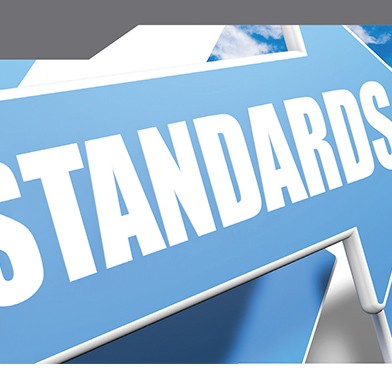Understanding the New ISO Accreditation
Laboratories around the world process and analyze hundreds of thousands of samples each day, but the results could cause health, safety and economic risks without an assurance of testing competency and accuracy.
The International Organization for Standardization (ISO) has been one of the world’s largest sources of voluntary international standards for manufactured, agricultural and technological products and services since the 1940s.
In the 1990s, ISO expanded its standards to laboratories and producers of reference materials who pursue ISO accreditation. The standard for laboratory and reference materials has recently been updated and, SPEX CertiPrep has developed these answers to common questions about ISO accreditation and how the recent updates may affect you.
What is accreditation?
Accreditation is the confirmation of the competence of a testing or calibration laboratory or reference material (RM) producer. Accreditation is typically performed by an unbiased independent third party (or accreditation body) that measures to an ISO international standard.
How do we become an accredited laboratory or reference material producer?
- Complete and submit an application for accreditation to a third-party accreditation body for a particular ISO standard
- Undergo the necessary competency evaluations, including a technical review of procedures, periodic on-site audits, and the results from proficiency testing
- Review the deficiencies report and make the necessary corrections to receive accreditation
What is ISO/IEC 17025?
ISO/IEC 17025:2017 is the standard for the “General Requirements for the Competence of Testing and Calibration Laboratories.” Originally issued in 1999, it was released again in 2005 with five new elements: scope, normative references, terms and definitions, management requirements, and technical requirements.
The management requirement section relates to the laboratory’s quality management system. The technical requirements section addresses the reliability of tests, products and calibrations, including accuracy, precision, stability, homogeneity, traceability and uncertainty.
How are accuracy, precision, stability, homogeneity, traceability and uncertainty defined?
- Accuracy is the degree to which a result or measurement reflects the true value of the result; precision measures how closely repeated measurements agree
- Stability is a state of non-reactivity during normal use; unstable materials may corrode, decompose, polymerize, burn or explode under normal conditions or during use
- Homogeneity is the quality of uniform composition or character; for reference materials, these can be in-bottle or between-bottle or lot
- Traceability is the tracking and documentation of the product or service from the point of origin, through manufacturing/service, and to the final analysis, delivery and receipt
- Uncertainty is the confidence that the true value lies within a specific range of values; uncertainty includes random variables (changes in temperature, humidity, drift), instrument/analyst variability, and homogeneity factors (changes due to storage and/or transportation conditions) and any other variables
Note: Uncertainty is not the same thing as an error or mistake.
What are the main differences between ISO/IEC 17025:2005 and ISO/IEC 17025:2017?
Many of the changes close verbal loopholes which allowed for different interpretations, including:
- The range and scope of laboratory activities
- Use of certified reference materials and traceability
- Increased periodic reviews and controls for environmental conditions (laboratory access and contamination)
- Definition of equipment that includes instruments, software, data, standards, reference materials (RM), reagents, consumables and other apparatus
- Use of statistical methods (control charts, stability charts, uncertainty calculations)
- Emphasis on impartiality and confidentiality
- Definitions and documentation of staff competency
- Records of staff and personnel supervision and monitoring
- Risk-based management reviews
What do these changes mean for users?
- Laboratories operating under ISO 17025 must now provide much more documentation regarding risk analysis and security
- Laboratories must prove accuracy, precision and competency data based on certified reference materials provided by accredited reference materials providers
- Companies that produce reference material have to provide more detailed information regarding use, storage and stability, including instructions for maintaining the certified values of the standards during normal use and within the product’s stated timeframe
What is the current version and how are changes made to ISO/IEC 17025?
The latest version was released on November 30, 2017.
ISO/IEC member bodies nominate industry experts to evaluate the need for revisions. Changes are based on the examination of common terminology and structure of other standards, web-based user surveys, collected support and guidance notes, suggestions for new quality concepts, and other recommendations.
What is Guide 34 and how does it relate to ISO/IEC 17034?
Guide 34 was originally drafted by ISO/REMCO in 1991 and published in 1996 as the “General Requirements for the Competence of Reference Material Producers.” It required demonstrations of scientific and technical competence, the provision of certified values, and supplementary information about reference materials, including traceability, uncertainty, preparation, and methods of measure. Updated in 2009, it was changed to standard ISO/IEC 17034 in 2016.
What are the differences between Guide 34 and ISO/IEC 17034?
ISO 17034 includes references to ISO 17025 (previously discussed), ISO Guide 31: Reference Materials – General and statistical principles for certification, and ISO/TR 16476: Establishing and expressing metrological traceability of quantity values assigned to reference materials.
In addition to wording/terminology enhancements, the accuracy and stability of reference materials is addressed:
- Reference material identity verification
- Storage and use guidelines to maintain material stability
- Indication of secondary parameters (temperature, humidity) that may influence the traceability of certified values (or uncertainty)
- Instructions for maintaining material stability, including repeated use or sampling
- Identification of uncertainty contributions

